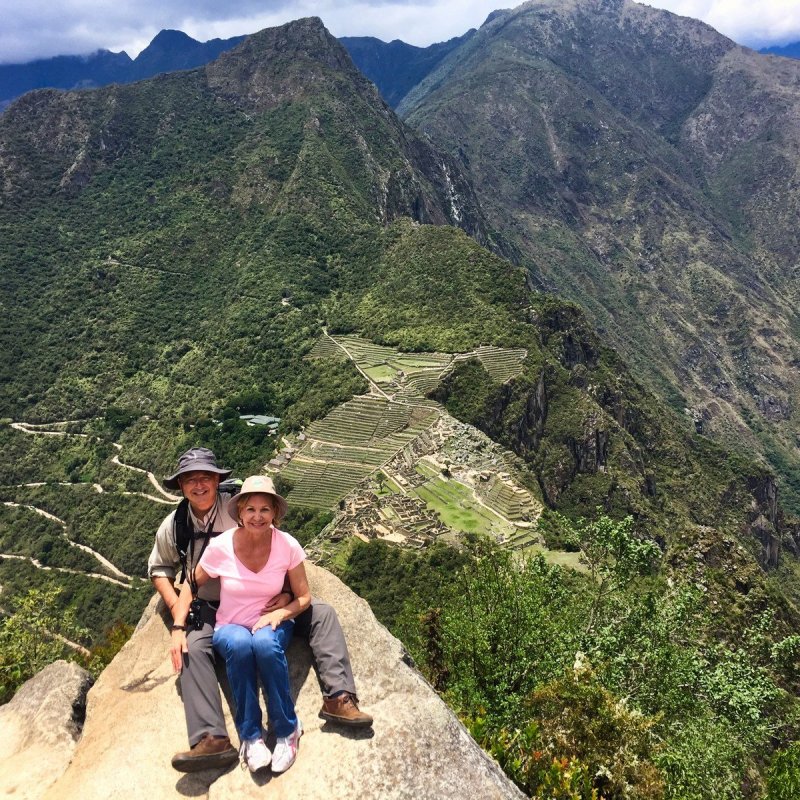
When most people think of Peru, they think of Machu Picchu, the remains of the once-mighty Inca Empire. They may also think of the lush Amazon Basin, which covers half of the country. But the unique culture of Peru is just as impressive as the country’s ruins and rainforests.
Videos by TravelAwaits
Peruvian culture is a lively mix of Hispanic and native traditions. The Quechua and the Aymara are the two main native groups of Peru, and both speak their native languages in addition to Spanish. Many Peruvians have Incan ancestry as well. The native people of Peru have managed to preserve and develop their unique culture despite centuries of outside influence. If you are planning to travel to Peru, here are nine things you should know about the country’s incredible culture.

The people of Lake Titicaca are masters of the ancient art of weaving. Photo Credit: Retire Early and Travel
1. Peruvians Express Their Culture Through Dress
In the Andes of Peru, people dress according to the particular style of their region or group.
The indigenous women of the Andes dress in layers of bright, colorful traditional clothing. They wear capes, shawls, embroidered skirts, and brightly colored hats. Not all Peruvians dress in traditional clothing, however. Many Peruvians, even indigenous people, wear modern clothing most of the time and traditional clothing only on special occasions. Others wear beautiful traditional skirts and even hats to work in the fields.
Traditional Peruvian garb for men includes knee-length or long dark handwoven pants. However, in the Patacancha region, men wear beige or white pants. You may also see Peruvian men wearing jeans and T-shirts.
If you are near Lake Titicaca or the Capachica Peninsula, where almost all practice the ancient art of weaving, you will see few people in modern clothing. Not only do the inhabitants of that area weave, but they also knit and embroider.
On Taquile Island on Lake Titicaca, men wear black pants, white shirts, and colorful waistbands. A Taquile Island man’s marital status is communicated by the color of his woven woolen hat. Married men wear red hats, and single men wear red and white chullos, or stocking caps.
If you love clothing, design, or color, you will be impressed by Peruvian attire.

Tina spends some time with women from Cusco, Peru. Photo Credit: Retire Early and Travel
2. Peruvians Value Courtesy
Peruvians are friendly people, and they are thrilled to welcome visitors to their country.
Spanish is the official language of Peru. English is typically only spoken in hotels and restaurants in the larger cities of Peru, and the local people seldom speak English. Before you depart on a trip to the area, you should know how to say a few things in Spanish, including please, thank you, good morning, good afternoon, and good evening.
If you ask someone for help, you must first wish them a good morning, good afternoon, or good evening, and then you can muddle through your request. It is not appropriate to walk into a store and say, “Excuse me, but do you have…” The shopkeeper will probably wish you a good afternoon and wait for you to wish them a good afternoon in return. Then they will hear your request. It is considered rude not to say the appropriate greeting before asking a question.
It is also important to practice courtesy when taking photographs. Many of the women dressed in beautiful traditional garb will gladly let you take their picture if you ask politely. They may ask for a coin. But some will not want you to take their picture even if you pay them, and it is important to respect their wishes.

Peruvians use alpaca wool to make clothing and other textiles. Photo Credit: Retire Early and Travel
3. Peruvians Are Fantastic Artists
While you are in Peru, you will want to experience the country’s ancient and modern art. Ancient Peruvian art includes jewelry, woven items, and stone and metal carvings. Most of these items were crafted by the people who lived in the Andes prior to the arrival of the Incas and the Spanish.
Contemporary Peruvian art reflects the influence of the Incas and the Spanish. Cotton, llama wool, alpaca wool, and sheep’s wool are still spun by hand into yarn. The yarn is then used to make clothing and other textiles. In the many markets of Peru, you will find other crafts handmade from wood, gold, or silver.

Music and dance are important to Peruvians. Photo Credit: Retire Early and Travel
4. Music And Dance Keep Peruvian Culture Alive
Music and dance are extremely important in Peruvian culture. Each region has its own unique style of music and dance.
Peru’s rich musical heritage consists of instruments and styles passed down by the Incas, the Spanish, and even African slaves. Tiny flutes and mini guitars feature prominently in the area’s music, and today, Peruvians incorporate new instruments with folk instruments. If you want an authentic Peruvian experience — if you want to get to the heart of Peru — you must spend some time listening to the country’s music.
Peruvians also take dance very seriously. Peru’s blend of cultures is quite evident in the country’s traditional dances. For thousands of years, dance was associated with war, agriculture, hunting, and even work.

Alpaca meat is a Peruvian staple. Photo Credit: Retire Early and Travel
5. Peruvian Food Is Unique And Delicious
How can you talk about a country’s culture and not talk about its food? The range of climates in Peru results in an incredible variety of produce. Potatoes, corn, and grains (especially quinoa) are Peruvian staples.
So what dishes should you try during your time in Peru? Ceviche, Peru’s national dish, consists of only five ingredients: corvina marinated in lime juice, onions, salt, and hot chilis. Ceviche is often served with dry-roasted corn kernels on the side.
If you want the full Peruvian food experience, you will have to try cuy, or guinea pig. Cuy is one of the Andean region’s most popular sources of meat. The traditional method of cooking it is to fill the whole guinea pig with herbs and roast it over an open flame. It is usually served with roasted new potatoes. High-end restaurants will deep-fry or braise the cuy.
Another traditional Peruvian meat is alpaca, the smaller cousin of the llama. Alpaca is very lean and is similar to buffalo meat.
A Peruvian drink you must try is chicha morada, a nonalcoholic beverage made from purple corn. Chicha morada is sweet and served cold.
When it comes to alcohol, Peru is famous for the pisco sour. Pisco is a type of brandy made from grapes; it has a proof in the mid-80s. The pisco sour consists of pisco mixed with lime juice, simple syrup, bitters, ice, and a raw egg (to give the drink a foamy top).

Religious celebrations, like this one in Puno, Peru, are an important part of Peruvian culture. Photo Credit: Retire Early and Travel
6. Religion Is An Important Part Of Peruvian Culture
Peru’s culture is so intertwined with religion that it is impossible to experience one without the other. Most Peruvians are Roman Catholic, but some are members of other Christian faiths. The indigenous people of Peru practice Catholicism in a way that incorporates many of their traditional beliefs; Catholicism in Peru is full of pre-Columbian symbolism and ritual elements. This blending of beliefs is evident in the religious festivals that take place across Peru throughout the year.

A Peruvian festival wouldn’t be complete without a parade. Photo Credit: Retire Early and Travel
7. Peruvians Celebrate In Style
If you’re planning to visit Peru, you might want to go during a festival. Peruvian festivals are colorful and lively and almost always include parades.
As I mentioned before, Peruvian festivals feature Catholic themes blended with traditional elements. Observing — or even taking part in — one of these festivals is a treat. Semana Santa is probably Peru’s biggest religious festival. Celebrated the week before Easter Sunday with enormous daily parades in many parts of Peru, Semana Santa attracts many visitors.

Peruvians are less concerned about punctuality than people in the United States. Photo Credit: Retire Early and Travel
8. Peruvians Have A Different Concept Of Time
If you are going to visit Peru, you must understand that the culture of time is quite different there. Peruvians aren’t as concerned about punctuality, don’t mind if they are delayed, and are not upset when someone is late. If you are invited to a party that starts at 7 p.m., you are not expected before 7:45 p.m., and showing up at 7 p.m. would be considered rude. You may have heard this referred to as mañana time, or “tomorrow time.”
Family is very important to Peruvians, and they put spending quality time with family ahead of everything else when it comes to time.

In Peru, people shop at markets like this one. Photo Credit: Retire Early and Travel
9. Peruvians Shop At Markets, Not Megastores
Many people love to shop when they travel. In Peru, people shop in markets, not megastores. Peru’s markets are the perfect places to experience the country’s people, food, and culture. But be prepared: All markets expect some form of bargaining. You will need local currency in small denominations. Merchants do not like to give change and are rarely prepared to do so. Credit cards are not usually accepted, and although some places make take U.S. dollars, you will most likely overpay.
About The Author
Tina Paul is a destination and experience marketer and the founder of the blog Retire Early and Travel. Her site covers retiring early, living abroad, and experiencing different cultures.
Photo Credit: Retire Early and Travel
